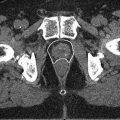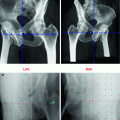© Springer-Verlag Berlin Heidelberg 2014
Hans Geinitz, Mack Roach III and Nicholas van As (eds.)Radiotherapy in Prostate CancerMedical Radiology10.1007/174_2014_1008Value of Patient Immobilization in External Beam Radiotherapy for Prostate Cancer
(1)
Department of Radiation Oncology, University Hospital Zurich (USZ), Rämistrasse 100, CH-8091 Zurich, Switzerland
Abstract
Recent developments in external beam radiotherapy for prostate cancer (dose escalation, hypo fractionation) require more accurate treatment delivery. This chapter summarizes the value of external patient positioning devices as well as diets to reduce prostate position variability.
1 Introduction
The practice of external beam radiotherapy (EBRT) for localized prostate cancer has undergone substantial changes in the recent years. Several prospective trials consistently demonstrated improved biochemical control after treatment with escalated irradiation doses of 74–78 Gy. Studies with long-term follow-up suggest that this improved biochemical control transfers into improved freedom from distant metastases (Zelefsky et al. 2011) and cancer-specific survival (Kuban et al. 2011). The low alpha/beta ratio of prostate cancer was confirmed in a recent study based on almost 6,000 patients and was independent of the risk stratification and treatment with androgen deprivation (Miralbell et al. 2012). This further supports evaluation of hypo-fractionated protocol and early results are promising (Arcangeli et al. 2012; Dearnaley et al. 2012). The role of prophylactic pelvic irradiation remains controversial after two randomized trials. However, despite the lack of high-level evidence, pelvic irradiation is practiced by many centers based on surgical practice of extended lymph node dissection and experiences from other cancer types (Morikawa and Roach 2011), where prophylactic lymph node irradiation is standard of care.
All these recent developments—escalation of the irradiation dose, hypo-fractionation and pelvic irradiation—bear the risk of increased rates of toxicity. As a consequence, an improved accuracy of external beam radiotherapy (EBRT) is warranted to counterbalance all these potential detrimental effects. In principle, two technological strategies are currently explored in EBRT of prostate cancer: (1) reduction of inter-fractional and intra-fractional target position uncertainties to subsequently reduce safety margins and improve sparing of critical Organs-At-Risk (OAR); (2) improved conformity of the irradiation doses to the complex shaped target volumes in prostate cancer to minimize incidental irradiation of OARs.
2 Patient Positioning and External Patient Immobilization
Four randomized trials have been conducted, all addressing the issue of patient positioning and immobilization in prostate cancer.
Nuttling et al. (2000) compared a “conventional treatment position” (supine with a foam head pad and the ankles immobilized in ankle stocks) and an immobilization system, where a customized cushion supported the pelvis from the iliac crest to the upper thigh; a foam head pad and ankle stocks were used in analogy to conventional positioning. Thirty patients were randomly assigned to these two positioning systems and patient setup errors detected in electronic portal images (EPI) were the primary endpoints of this study. Based on a total of 1,600 EPIs, no statistically significant difference in systematic and random patient positioning errors were detected. Radiographers reported that patients found the immobilization device more comfortable, but when using the immobilization device, they noticed greater difficulty in patient positioning and alignment to skin tattoos. Based on the results of this study, the authors stopped the use of the immobilization device in their clinical practice.
Kneebone et al. (2003) randomly assigned 100 prostate or bladder cancer patients to either prone positioning with no immobilization devices or prone positioning using a customized Uvex cast of the pelvis as well as ankle- and shoulder-stabilizing devices. Patient setup errors based on the pelvic bony structures were evaluated in weekly acquired EPIs. The more rigid immobilization method significantly decreased setup error uncertainties: major deviations >10 mm were reduced from 31 to 11 %. Systematic errors especially in anterior-posterior direction were reduced by the more rigid immobilization (from 2.4 to 0.8 mm). No differences in patient comfort and total treatment time were reported between the two positioning procedures.
Bayley et al. (2004) asked the important question of supine versus prone patient positioning in prostate cancer. Twenty eight patients acted as their own controls: they were randomly assigned to start treatment in either supine position (immobilization in a customized Vac-Loc) or prone position (immobilization in a customized Hip-Fix); after midpoint of the irradiation course, treatment was re-planned and finished in the other position. In contrast to the previous two studies, prostate motion was analyzed via lateral EPIs of prostate implanted fiducial markers. The study clearly demonstrated that prostate motion in the anterior-posterior direction was significantly smaller in the supine position. Larger safety margins were required in prone position to account for this increased prostate motion, which then resulted in increased dose exposure of the OARs bladder, small bowel and rectum. Additionally, supine position was significantly more comfortable for the patients and setup was significantly easier for the radiation therapists.
Rosewall et al. (2008) evaluated inter- and intra-fraction prostate motion in a standard VacLok immobilization device or in the BodyFix system incorporating an abdominal compression element, which may reduce abdominal movement. Prostate motion was analyzed via daily pre and posttreatment assessment of prostate implanted markers in EPIs. In summary, immobilization in the BodyFix system with abdominal compression did not influence inter-fractional or inter-fractional prostate motion compared to a standard VacLok.
These four studies suggest that patients should be treated in supine position: advantages are reduced intra-fractional prostate motion, best patient comfort, and simultaneously easiest patient setup by the RTTs. No clear advantage of more advanced immobilization devices compared to a standard knee and ankle support could be demonstrated.
Stay updated, free articles. Join our Telegram channel

Full access? Get Clinical Tree







